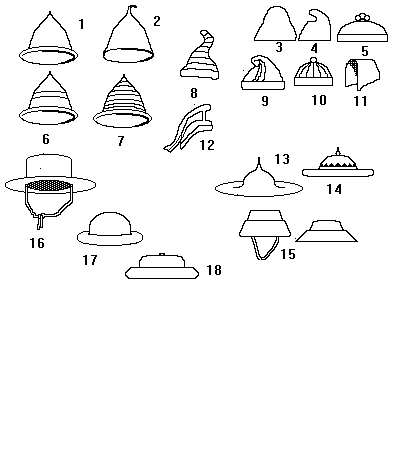Caps

- English (Late 11th century). This hat is most likely either a felt cone, or an assembled
cap.
- English (1180-1190). The tab at the peak is quite common. Note that this same design is
also appropriate for a 4th century Jew.
- Anglo-Saxon Cap
- Anglo-Saxon Scythian Cap
- Anglo-Saxon (c9th - 11th century)
- English (1180-1190)
- English (c1260)
- This *looks* like a simple knitted cap, although it could be intended to represent a
crushed felt cone.
- Anglo-Saxon Scythian Cap
- Anglo-Saxon Cap
- Anglo-Saxon - an early version of the coif?
- A stylized "Scythian Cap" sometimes seen in Illustrations.
- This style of hat is most often worn as part of the legislated clothing intended to
single out the European Jews (12th century)
- As above, this is also a "Jew's Hat". This design is sometimes seen in straw?
- Worn both with a chin string, and without, this basic design is seen over again, from a
Cardinal's "Red Hat" (14th Century) worn with cords, beads and tassels, to a
straw hat (1350-1420), and an Italian Felt Hat (c1470)
- Resembling a "top hat", this is, in fact, a Beaver hat. Before the 16th
Century, the Beaver fur was not felted, but rather left on the skin, and the hat made of
the leather.
- This basic style is seen in felt, straw and in later era knitted caps.
- Another possible rendition of the previous style.
Some Headwear of the Middle Ages - Caps & Coifs, by I. Marc Carlson. Copyright
1996.

